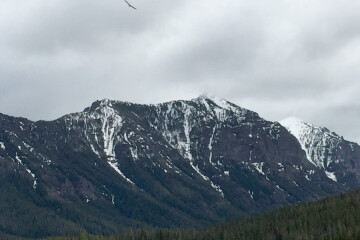A History of Bozeman’s Water System Part III
This article is the last in a series of three articles telling the history of Bozeman’s water system. Part I & II can be founding the May and June Bozeman Magazine.
The development of Bozeman’s water system has three distinct phases which mirror the evolution of water resource development in the American West. This article covers the third phase of development of the Middle Creek, now known as Hyalite, drainage during the Depression Era. As with many larger projects throughout the West, the dam creating Hyalite Reservoir received initial construction funding from the Depression-era Public Works Administration (PWA).
Use of Middle Creek for agricultural irrigation began in 1871, when the Upper Middle Creek Ditch Company was formed. At the same time George Flanders acquired all the timber rights in the Middle Creek Canyon, where he built splash dams across the creek to aid floating logs down to his mill at the mouth of Middle Creek Canyon. With Flanders’ other facility at Bear Creek, the Middle Creek mill supplied lumber and shingles to enlarge Fort Ellis in 1872. The business was so successful that Flanders opened a lumber yard in Bozeman to market his products in 1884.
The Middle Creek area became the Gallatin National Forest in 1907. After paying the licensing fees, Flanders cut two million board feet a year from the Middle Creek drainage until he closed the operations in 1911. Flanders also developed hydroelectric facilities on Middle Creek, which was eventually acquired by the Montana Power Company. By 1919 Bozeman’s residents used the Middle Creek area for recreation so heavily that Bozeman businessmen and the City Commission pressured Congress to preserve the Middle Creek valley from development.
Despite the economic catastrophe that started for Montana in the late 19teens with the homesteading bust, Bozeman’s economy fared relatively well through the1920’s and the “Dirty 30’s.” Enrollment at Montana State College continued to grow and, aided by decent moisture, Bozeman’s agricultural economy remained steady.
To serve municipal users, the City purchased additional shares in the Bozeman Reservoir Company in the 1920’s and 1930’s. The City preferred new water resources from the south of town which enabled the City to use gravity to bring water through the City’s infrastructure of clay and steel water transmission lines, sediment settling ponds and residential distribution system.
Beginning in 1933 President Roosevelt’s New Deal brought a massive influx of federal investment to Montana, especially through the PWA which funneled money for water resource development through the Bureau of Reclamation. Montana’s Water Conservation Board, chaired by Democratic Governor Roy E. Ayers, directed the federal funding towards the construction of dams to create reservoirs of water which would enable irrigation of farmland, control floods and create hydroelectric facilities.
In addition to the mammoth Fort Peck Dam, smaller projects included the Ackley Lake project and Ruby River project. By December of 1937, the PWA had 2,650 men at work on water conservation jobs throughout the state.
Bozeman’s government agencies requested PWA funding for a variety of public projects in the late 1930’s. Willson School, the Gallatin County Courthouse, Hawthorne, Irving and Longfellow Schools are prominently known PWA projects. Lesser known PWA projects include the Montana Department of Transportation yards on North Rouse Avenue, landscaping in Lindley Park and construction of Bogert Pool on South Church Avenue.
Federal funding improved recreational facilities in the Middle Creek area, including a Boy Scout camp in 1935, improvements to the road and construction of trails by the Civilian Conservation Corps in 1937-39 and construction of campgrounds.
With the support of Congressman Jerry O’Connell, representing Montana’s First District, the Water Board continued to expand water reclamation projects throughout the state. Assistant Commissioner of the Reclamation Bureau R. B. Williams, a Bozeman native and 1911 graduate of MSC, likely played a large part in securing funding for Montana.
At a Chamber of Commerce meeting in May of 1938 the Board’s vice chairman Rockwood Brown touted the Board’s success. Brown noted that in three years sixteen projects were built or were under construction. At a cost to the state of $6 million dollars, the completed projects would provide over 300,000 acre-feet of water for lands under them at the rate of about $20 an acre foot.
Brown said the Board had “every reason to believe the Middle Creek project will be approved for PWA construction in the near future.” Located 14 miles south of Bozeman, the project would store 4,000 to 10,000 acre feet of water and cost about $350,000. The funding stream would be 45% from a grant and 55% a loan to the water conservation board.
The City of Bozeman supported the project, and eventually contracted for 500 acre feet of water from the reservoir. In explaining the turn away from preserving the Middle Creek drainage for recreation, Mayor Augustus Lake wrote the Forest Service, “The City of Bozeman has…to be on the lookout for more water and always welcomes any new source of supply, and as the prosperity and happiness of the people of Bozeman depend very largely on the success of the farmers in the Gallatin Valley we deem it our duty to support things helpful to the farming industry even though it may necessitate a modification of former plans.”
The PWA approved the project a month later, in June 1938. In May 1938 the Board awarded the contract for dam construction to R. P. England for the amount of $347,189.82. Excavation for the earthen-fill dam began in July 1939, but was quickly halted when a 30 foot deep quicksand pocket was discovered. After relocating the selected site, the contractor fought a short construction season and difficulty finding materials until 1942, when contractor England’s equipment was requisitioned for World War II purposes.
After the war, England sub-contracted the work to Beaver Construction Company, who completed the project between 1946 and 1951. The dam and reservoir became fully operational in the mid to late 1950’s and was officially renamed Hyalite Creek and Reservoir in 1969.
Two transmission water lines now carry water from the mouth of Hyalite Canyon to Bozeman’s water treatment plant on Bozeman Creek. Forty percent of Bozeman’s domestic water comes from Hyalite, forty percent from Bozeman Creek and twenty percent from Bozeman’s original water source at Lyman Creek.
Courtney Kramer is a proud graduate of MSU’s History Department and serves as the City of Bozeman’s Historic Preservation Officer. She may be contacted at the City Planning Office, 406-582-2260 or via email at: ckramer@bozeman.net. More information about Bozeman’s historic districts is available at: www.preservebozeman.org



